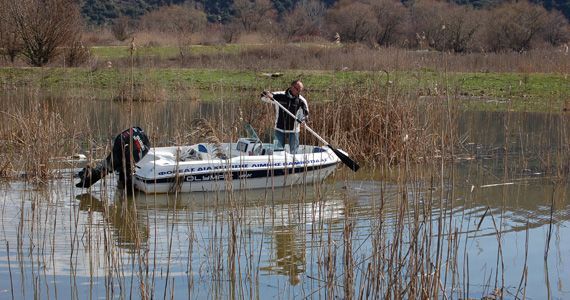Safeguarding/ Surveillance of the Protected Area
Safeguarding/ Surveillance of the Protected Area is one of the Management Body’s (M.B.) basic responsibilities under the Law no. 2742 / 07.10.1999 (Government Gazette A '207 / 10.7.1999). The jurisdiction area includes virtually the entire basin of Ioannina.
Two guards are employed with experience in safeguarding/ surveillance of Protected Areas. The Management Body for the guarding / surveillance programme provides two vehicles and a boat. Also binoculars and telescopes facilitate the work of the guards, as from appropriate sight positions the whole region can be observed.
Prior to the establishment of the M.B., a chaotic situation was existing in the lake, mainly due to uncontrolled infillings, widespread pollution, uncontrolled hunting and illegal fishing. Today, due to the daily patrols of guards, the situation has been improved significantly.
The main illegal actions detected are related to:
Illegal solid waste deposition
The pollution with solid waste is the commonest illegal action, which the guards observe. Deposition of waste is a serious problem not only for the protection of the environment but also for human health. The uncontrolled disposal of solid waste within and outside urban areas is prohibited in accordance to the Law 1650/86 "on the protection of the environment”. Anyone who causes pollution or environmental degradation is facing criminal, civil and administrative sanctions according to Articles 28, 29 and 30 of Law 1650 / 86. If an illegal waste deposition is observed, the guards attempt to identify the polluters and impel them to remove the waste.
Discharge of untreated urban and industrial wastewaters.
One of the major problems in the jurisdiction area of the Management Body is the disposal of untreated urban and livestock waste in ditches, which flow into the lake. Pollution of surface water from the discharge of untreated sewage, not only contributes to the degradation and destruction of habitats of many aquatic organisms, but also to the degradation of the lake’s sensitive wetland ecosystem.
Illegal hunting
The lake is a protected area included in the NATURA 2000 network, in which some activities, such as hunting (around the lake), are prohibited. For this purpose, there is a ban with a 5 years duration, which determines the prohibition area limits. Here lies the major problem: despite the repeated recommendations of the Management Body to the Forestry department to include in the boundaries of the prohibition area the public roads, the situation remains unclear. The boundaries are very close to the lake and the safeguarding of the restricted area by the wardens of the local hunting association, is lacking. Nevertheless, daily patrols both around and inside the lake mainly during the hours that illegal hunting is usually performed (sunrise and the sunset) act as a deterrent. Since the ban area limits are so close to the lake, legitimate hunting continues and hunters even propose to permit hunting in some areas around the lake.
Infillings
Regarding the illegal infillings, there were several cases that offenders were observed during patrols. Subsequently, they were asked to present their permit. Today, the illegal infillings have been reduced significantly.
Illegal Fishing
The law specifies that fishing is allowed only with gillnets. However, illegal fishing gears can still be observed in the lake, such as fixed gillnets (on stakes), fyke nets, bait cages or “daoulia”, longlines and during the breeding season the traditional harpoon or “kamaki”. The fisheries department of the Epirus Prefecture informed the Management Body that all licenses define gillnets as the only professional fishing method. Therefore, in co-operation with the relevant authorities, the fishermen should be informed regarding the permitted fishing gear, so that if there is no compliance, to take measures accordingly. Also worth mentioning is that fishing is prohibited during May, when the fishes spawn. In addition, during September to January the fishing is prohibited within 100 meters of the coast of the Island, as during these months there are large bird populations (mainly Eurasian coots) in the area, which in the past were trapped in illegal nets put specifically for this purpose.
Other offenses are the illegal clearances of the riparian vegetation, the pollution from livestock waste, illegal domestic wastewater inflows, etc.












